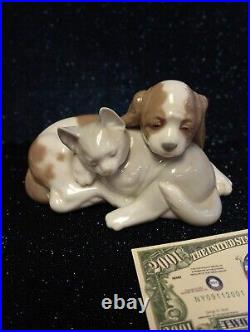Lladro Figurine Bosom Buddies 6599 Dog & Cat





World of Lladró A story of passion for porcelain Lladró is the success story of an iconic Spanish brand. A world leader in the design, manufacturing and distribution of porcelain art creations, Lladró is a unique mix of talent, audacity and meticulousness in the quest for excellence. From sculpture to lighting, home accessories and jewelry, Lladró is a brand that stands for a contemporary, stylish and exclusive lifestyle. Brothers Juan, José and Vicente Lladró The 1950's: The beginning of the adventure Lladró is the story of the passion for porcelain of three brothers, Juan, José and Vicente Lladró. Artists who made porcelain into a way of life and managed to build a business empire with their own hands. In 1953, at their home in the village of Almàssera, they began to make their first plates, vases and ceramic figurines inspired by the works of the great European manufacturers of Meissen, Sèvres and Capodimonte. It is in this period that the modeling of flowers or the complex treatment of tulle first appeared, examples of virtuoso techniques that we still find today in many of the brand's creations.
First Lladró workshops The 1960's: The consolidation of a style Fruit of constant artistic restlessness, at this time a unique and distinctive style is forged, with elongated lines, which makes Lladró works world-famous. Lladró introduced the revolutionary single-firing method which soon replaced the tradition triple-firing. This pioneering method also helped to define another hallmark of the brand: the characteristic pastel tones of a large part of its work. In this decade, the Professional Training School was also founded at its headquarters to provide the company with qualified artists and technicians. In 1965, with little more than a decade to its credit, Lladró entered the American market.
And in 1969, Lladró opened its current headquarters in Tavernes Blanques (Valencia). Lladró artisans Iconic Don Quixote figure The 1970's: Recognition The 70s are years of feverish activity and creative maturity. The quality achieved leads Lladró to undertake more ambitious works, the first limited series are born and the definitive international recognition arrives. After intensive research, it begins to work with gres, a new material that opens up a whole world of expressive possibilities.
The particular resistance of this material and its characteristic earthy tones expand the creative resources of Lladró's artists. The 1980's: Reaching new heights In the 1980s, the constant search for new ways of expression continued apace. Greater control of porcelain enabled creations that show an extraordinary mastery of modeling. In singular collections like Sculptures, Caprices or Goyescas, the artists' imagination is carried away by fantasy and the pleasure of creation. The Lladró Collectors' Society was founded in 1985. Over its 15 years of existence, it boasted more than 100,000 collectors of the brand's porcelains. In this decade Lladró reaches two major milestones in its international expansion.In 1986 Lladró disembarked in Asia with subsidiaries in Japan and China. And in 1988 it opened its first museum and gallery in New York City, on Fifth Avenue in Manhattan. And the process of internationalization continued steadily in emerging markets like Russia, Eastern Europe or India.
Lladró gallery in New York Map of Asia with porcelain texture The 1990's: Excellence In the nineties Lladró produced many highly complex period scenes, most of them incorporating vivid floral compositions which represent the greatest expression of the painstaking attention to detail and know-how of Lladró artists. In 1991, the Hermitage Museum in St. Petersburg hosts an exhibition of Lladró sculptures from which the 18th Century Coach and Don Quixote will become part of its permanent collection. In 1995 the first Lladró boutique opened in Tokyo, in the fashionable district of Ginza; in 1996 its first own store opened in calle Serrano, the exclusive street in Madrid, and in 1997 the Beverly Hills boutique opened its doors in Rodeo Drive.
In this decade Lladró receives two prestigious awards: the Príncipe Felipe Prize for Internationalization in 1993 and the Príncipe Felipe Prize for Competitiveness in 1997. The 2000's: New Paths Lladró takes its expressive potential to new heights in High Porcelain, a collection of pieces with extraordinary artistic and technical quality, destined to form a select group of masterpieces within the brand's production. At the same time, Lladró reinvents itself with sculptural pieces in matte white porcelain or dynamic and expressive pieces decorated in vivid colors. In this decade Lladró received the Príncipe Felipe Award for Renowned Brand Management (2002). Lladró boutique with High Quality Porcelain figures Pieces dedicated to religious traditions and beliefs begin to play a prominent role.One of the brand's values since its origins is its know-how in addressing the spirituality of the most diverse cultures with sensitivity and admiration, making each piece a challenge and a source of enrichment for its artists. In 2006 and 2009 Lladró opens two boutiques in Moscow, at the prestigious Petrovsky Passage and GUM mall, respectively. In 2012 the Lladró Boutique in New York City opens its doors at 500 Madison Avenue. In 2017 the company is acquired by the PHI Industrial Group, a Spanish investment fund specialized in the active management of companies.
Lladró Today The diversity of lines and styles Lladró offers today makes the brand extremely contemporary. Unexpected sculptures, functional lines like Light & Scent that feature home scents and innovative wireless lamps, large lighting collections, tableware, centerpieces, and jewelry. These are just some of the product categories that make up the company's current portfolio. A world of possibilities in porcelain, where the brand's talented creative teams collaborate with big names in design like Marcel Wanders, Nichetto Studio and Naoto Fukasawa. Lladró porcelain is unstoppable on its path where design, craftsmanship and care for the environment come together to continue creating with this living material that is always full of surprises. Make an offer available on all items. Many out of production and no longer available. PLEASE NOTE: WE SELL VINTAGE COLLECTIONS FROM AROUND THE WORLD. WE ARE NOT DEALERS OF NEW ITEMS. IF YOU WANT OUT OF PRODUCTION, OUT OF STOCK, DISCOUNTED ITEMS, RARE, SCARCE, WE ARE FOR YOU.OUR DESCRIPTIONS ARE THE BEST WE KNOW. IF IT'S NOT PHOTOGRAPHED IT'S NOT INCLUDED. WE DO NOT WANT ANY MISUNDERSTANDING ON DESCRIPTIONS. Powered by SixBit's eCommerce Solution.
